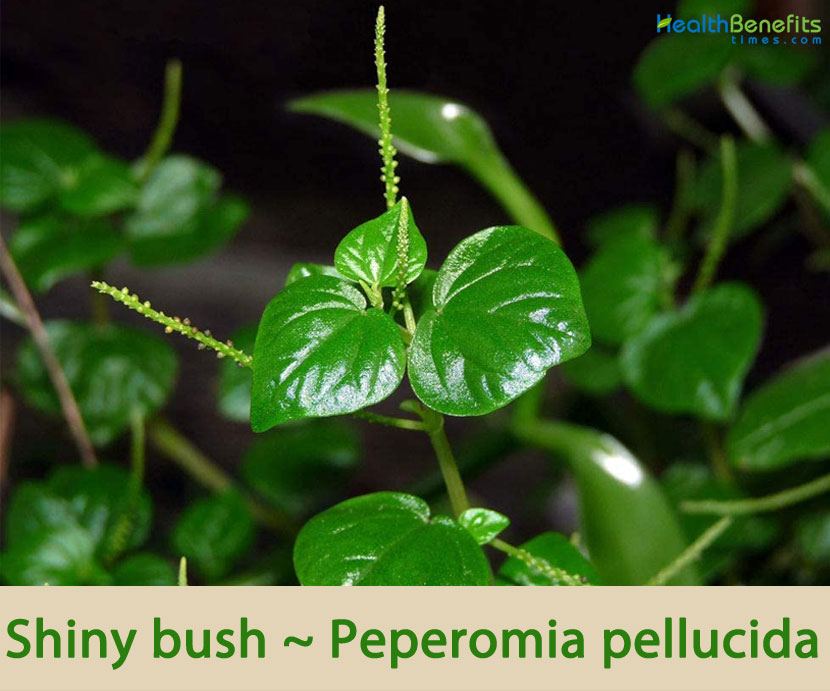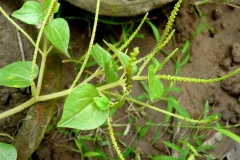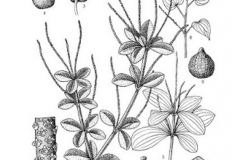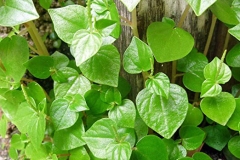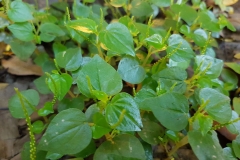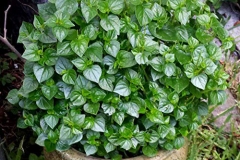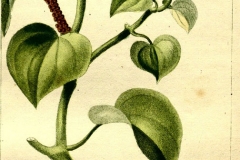| Shiny bush Quick Facts | |
|---|---|
| Name: | Shiny bush |
| Scientific Name: | Peperomia pellucida |
| Origin | Tropical Central and South America |
| Colors | Initially green turning to black as they matures |
| Shapes | Tiny, pin-head sized round to oblong, ridged fruit 0.5-1 mm in diameter, that are striped lengthwise |
| Health benefits | Treats Rheumatoid Arthritis, Treat urinary system problems, Treat gout and arthritis, Effectively Lower Blood Cholesterol Level, Powerful Anti-Bacterial Agent, Reduces Uric Acid, Powerful Anti-Inflammation, Depression, Powerful Anti-Fungal, Powerful Antioxidant, Heals Fracture, Cures Cancer, Incredible Gastro-Protective Properties |
| Name | Shiny bush |
|---|---|
| Scientific Name | Peperomia pellucida |
| Native | Tropical Central and South America. It is now widely distributed throughout the tropics and is often naturalized as a weed and occasionally cultivated. It is now cultivated throughout parts of India, Southeast Asia, Australia and the Pacific. In Africa it occurs from Senegal east to Eritrea and Somalia, and south to Angola, Zambia, Zimbabwe and Mozambique. It also occurs in Madagascar and Réunion |
| Common Names | Clearweed, Consumption weed, Man to man, Pepper elder, Rat ear, Shiny bush, Silver bush, Vietnamese crab claw, Slate pencil plant, Pansit-pansitan, peperomia, rat’s ear, rabbit ear |
| Name in Other Languages | Assamese: Ponounuwa,Ponounua, Pononoa Belauan: Rtertiil Bengali: Dīpta luci pātā (দীপ্ত লুচি পাতা) Bisaya: Olasiman ihalas Bikol: Sinaw-sinaw, tangon-tangon Brazil: Coraçãozinho or “little heart Cambodia: Krasang teap, krasaeangteab (ក្រសាំងទាប) Chamorro: Podpod-lahe, potpopot Chavacano: Clavo-clavo Chinese: Cao hu jiao, (草胡椒) Chuukese: Pukuson Cuba: Corazón de hombre English: Man to man, Pepper-elder, Rat-ear, peperomia, rat’s ear, shiny bush, silverbush, rabbit ear French: Pépéromia, herbe à couleuvre, cresson, salade soda, salade soldat, herbe à couresse Guyana: Soldier Parsley Haitian: Zèb kourès Ilocano: Lin-linnaaw Indonesian: Tumpangan air Japanese: Suna kosho Javanese: Sladanan Malay: Rangu-rangu, ketumpangan or tumpang angin Malayalam: Maṣittaṇṭ (മഷിത്തണ്ട്), mashithandu, veḷḷattaṇṭ (വെള്ളത്തണ്ട്), veḷḷappaccila (വെള്ളപ്പച്ചില), Kannadippacha, Mashitandu Chedi, Mashithandu,Maka-pacha, Slettipacha, Thaklippan, Mashipatcha, Mashitandu chedi, vellipachila, vella-paccha Nepali: Latapate (लतपते) Nigerian: Ewe rinrin Oriya: ଭୁରvଓ Burshavo Palauan: Rtertiil Persian: پپرمیا پلوسیدا Philippines: Ulasiman-bato, olasiman-ihalas, tangon-tangon Pohnpeian: Sekewenleng Portuguese: Erva de jaboti, Erva de jabuti, coraçãozinho, língua de sapo, erva de vidro Puerto rico: Prenetaria Samoan: Vao vai Sanskrit: Varshabhoo,Toyakandha Sinhalese: Diya thippili (දිය තිප්පිලි) Sonsorolese: Rum Spanish: Alumbre, coclaria, frescura, garrapatilla, parietaria, plataria, siempreviva, sacha-yuyu, yerba de plata, lombricilla, cordoncillo, hierba de sapo, mazamorra Sudanese: Sasaladahan Suriname: Konsaka wiwiri Swedish: Ogräspeperomia Tagalog: Pansit-pansitan, ulasimang-bato Thai: Kras̄ạng (กระสัง), pak krasang (ผักกระสัง), chaa kruut, phak haak kluai Trinidad: Shining bush Vietnamese: Rau càng cua, càng cua West Bengal: Luchi pata Yapese: Makel ni pan, opul kongkong |
| Plant Growth Habit | Erect, annual, fast-growing, much-branched, shallow-rooted herb |
| Growing Climates | Forests, rock crevices, bases of cliffs, open forests, around nurseries, greenhouses, degraded forest areas, wastelands, wet places within forests, shaded woods, around nurseries and greenhouses, along coastal plain, wooded rocky hillsides, flooded water courses, woodlands |
| Soil | Performs best on permanently damp, free-draining loam and sand soils of a moderately acid to alkaline nature, generally with a pH of 5.5 to 8.0, and on sites in filtered sun or light to medium shade |
| Plant Size | About 15 to 45 cm (6 to 18 inches) |
| Stem | Stems are translucent pale green, erect or ascending, usually 15-45 cm long, internodes usually 3-8 cm long, hairless |
| Leaf | Glossy green heart-shaped leaves up to 3.8 cm (1.5 in ) long, alternately and spirally arranged along the stems |
| Flower | Flowers are greenish, small and insignificant, borne throughout the year on slender flower-spikes arising at the tips of the stems. |
| Fruit Shape & Size | Tiny, pin-head sized round to oblong, ridged fruit 0.5-1 mm in diameter, that are striped lengthwise |
| Fruit Color | Initially green turning to black as they matures |
| Propagation | By seed, but is also possible by stem, leaf and leaf-bud cuttings |
| Flavor/Aroma | Mustard-like odor when crushed |
| Plant Parts Used | Whole plant, Leaves, stem |
| Health Benefits |
|
| Other Facts |
|
| Precautions |
|
Plant Description
Shiny bush is an erect, annual, fast-growing, much-branched, shallow-rooted herb that normally grows about 15 to 45 cm (6 to 18 inches) tall. The plant is found growing in forests, rock crevices, bases of cliffs, open forests, around nurseries, greenhouses, degraded forest areas, wastelands, wet places within forests, shaded woods, around nurseries and greenhouses, along coastal plain, wooded rocky hillsides, flooded water courses and woodlands. The plant performs best on permanently damp, free-draining loam and sand soils of a moderately acid to alkaline nature, generally with a pH of 5.5 to 8.0, and on sites in filtered sun or light to medium shade. Stems are translucent pale green, erect or ascending, usually 15-45 cm long, internodes usually 3-8 cm long and hairless.
Leaves
Leaves are spirally arranged, simple, shiny light green, ovate elliptical to broadly ovate or almost triangular. They are 2.5-3.5 cm long and 2-3 cm wide, entire, membranous when dry, 5-veined, base rounded to truncate and apex acute. Petiole is up to 20 mm long and about 1 mm in diameter, glabrous and stipules are absent. The leaves are sometimes harvested from the wild and used locally as a food, medicine and tea. It has a mustard-like odor when crushed.
Flowers
The flowers are very small bi-sexual, greenish, small and insignificant, borne throughout the year on slender flower-spikes about 3-6 cm long arising from the tips of the stems. Flowers are about 0.5 mm in diameter, fertile axis 2-5 cm long and about 0.5 mm in diameter.
Fruit
Fertile flowers are followed by tiny, pin-head sized round to oblong, ridged fruit 0.5-1 mm in diameter, that are striped lengthwise and with a single seed inside. They are initially green turning to black when completely ripe. After ripening, the fruit fall to the ground and the seed under moist conditions germinate readily. The plant is sometimes cultivated as a medicine and food crop in parts of the tropics, and is sold as a food and medicine in local markets.
Health Benefits of Shiny Bush
Shiny Bush or Peperomia Pellucida may have anti-cancer agents, potent antioxidant, anti-inflammation and other vital health properties. Below is some of the possible medicinal use of shiny bush.
1. Treats Rheumatoid Arthritis
Juice extracted from fresh stem and leaf in a form of decoction can be taken early morning and night for a specific number of days to deal with rheumatoid arthritis. However care must be taken as the concentration has a direct effect on you, short period after taken it.
2. Incredible Gastro-Protective Properties
Decoction of aerial parts of peperomia pellucida has shown to relief patients from ulcer. And from study’s evaluated extract from shiny bush have showed notable protection in various experimental models with significant pretreatment inhibition of gastric mucosa (a mucous membrane layer of the stomach, which contains the glands and the gastric pits) damage.
3. Cures Cancer
Shiny bush consists of good amount of Peperomin E which has shown to prevent the growth of cancer cells. Also extract from leafs of shiny bush have showed to possess anti-cancer activities from conducted research. Plant extract was found to inhibit the growth of various pathogens, bacterial and have inhibited 30% of DPPH {2, 2-diphenyl-1-picrylhydrazyl}, free radicals. DPPH is a dark colored crystalline powder composed of stable free radical molecules.
4. Heals Fracture
Aqueous extract of the whole plant of shiny bush, when rob around fractured bone accelerate the bone healing proving the health benefit of shiny bush powerful for fractured bone to heal faster. From several researches this has been proof to work efficiently and it is attributed to the mineral content present in shiny bush.
5. Powerful Antioxidant
This is a powerful health benefit of shiny bush. Study evaluated extract from shiny bush and results have showed the strongest free radical scavenging activity. Result concluded that the plant, Peperomia Pellucida or shiny bush is a good natural source for antioxidant therapy.
6. Powerful Anti-Fungal
Research conducted have shown that extract from leafs of peperomia pellucida have showed to be most effective antifungal activity against fungal growth.
7. Depression
Study’s conducted in Bangladesh; in the experiment mice were administered with extract from shiny bush to determine its depressant activity. Results from the study suggested that shiny bush extract has a dose dependent depressant activity that is helpful for treatment of excessive mental excitement disorder.
8. Powerful Anti-Inflammation
As we all know the pain accompany by inflammation, which is a physical condition in which part of the body becomes reddened, hot and swollen. Shiny bush extract of aerial part have showed a significant anti-inflammatory activity.
9. Reduces Uric Acid
From study’s conducted extract from shiny bush were administered to rats and their uric acid levels were monitored. Rats that were subjected to extract from peperomia pellucida indicated a 44% reduction of uric acid level in their blood, and those who were administered allopurinol drug shown 66% reduction in uric acid level. This result suggest that peperomia pellucida may contain compounds that may be used as an alternative to allopurinol to control Uric acid level
10. Powerful Anti-Bacterial Agent
Shiny Bush is utilized in the suppression of bacterial spread. Essential oils made by dissolving leaf and stem of shiny bush have showed to prevent the growth of bacterial and it is utilized for free radicals scavenging activities.
11. Effectively Lower Blood Cholesterol Level
Majority of us are aware about health problems associated with higher cholesterol level. Decoction made from Shiny bush, when taken in dose dependent help lower cholesterol level thus reduce the chance of getting heart attack, stroke and other heart related diseases.
12. Treat gout and arthritis
Herbal tea or decoction made of Shiny bush’ leaves are a traditional medicine for gout, arthritis, and other articular diseases or disorders related to joint.
13. Treat urinary system problems
In Philippines and some Asian countries, Shiny bush made into herbal tea or consumed as a decoction is believed to treat urinary or renal diseases. This is done by decreasing the level of uric acid in the body.
Traditional uses and benefits of Shiny bush
- Whole plant being crushed, mixed with water, heated, and then orally administered to stop hemorrhage.
- Root decoction is used for treatment of fevers.
- Mashed aerial parts is applied topically or used as dressing for wounds.
- It has been used in salads or as a cooked vegetable to help relieve rheumatic joint pain.
- The plant has been used to lower cholesterol in Northeastern Brazil.
- It has been used as a diuretic and to treat proteinuria in Guyana.
- In the Amazon region, it has been used as a cough suppressant, diuretic, and emollient, and to treat cardiac arrhythmia.
- Ethno-medicinal uses for the plant has been used for treating abdominal pain, abscesses, acne, boils, colic, fatigue, gout, headache, renal disorders, and rheumatic joint pain and to treat breast cancer, impotence, measles, mental disorders, and smallpox.
- Roots are used to treat fevers and the aerial parts are used as dressing for wounds.
- In Guyana and the Amazon region, it is a popular cough suppressant and emollient.
- It is also used to treat proteinuria.
- It is also used topically for skin disorders such as acne and boils.
- It is used to decrease uric acid levels, which is a cause of arthritis and gout.
- Solution of the fresh juice of stem and leaves is used against eye inflammation.
- It is also been applied against coughing, fever, common cold, headache, sore throat, diarrhea, against kidney – and prostate problems and against high blood pressure.
- In Nigeria and DR Congo it is used as an ingredient of an infusion for treating convulsions and tumors.
- In Sierra Leone, DR Congo, and also in the Philippines, the warmed leaves are applied to sores and boils.
- Leaves are applied as a poultice to treat breast cancer in Nigeria.
- An infusion of the plant or maceration, mixed with salt and palm oil, is taken against cough in DR Congo.
- Worldwide, especially in Brazil and China, the plant is used to cure furuncles, conjunctivitis and skin sores.
- In Surinam a solution of the fresh juice of stem and leaves is used against abscesses, furuncles and conjunctivitis.
- Leaves are used in a decoction to treat cough, fever and common cold, and are eaten fresh to treat headache, sore throat and kidney and prostate problems, and also against high blood pressure.
- Decoction or infusion of the plant is applied externally as a rinse against complexion problems in Philippines.
- The liquid from the soaked root is given to pregnant women to treat malaria in Kenya.
- In DR Congo a leaf infusion is drunk and leaf maceration is applied to the head to treat mental illness.
- The plant is boiled and the water drunk to relieve rheumatism and fatigue in Peninsular Malaysia.
- Juice of the leaves is prescribed for colic and abdominal pains, and the bruised leaves are applied to the temples to treat headache in Java.
- It is recommended to eat P. pellucida as a culinary herb because it has an aromatic taste and stimulates appetite and digestion.
- It is also applied against coughing, fever, common cold, headache, sore throat and diarrhea.
- Sap is used as eye drops to treat cataracts, infections etc.
- Infusion and decoction of leaves and stems are used for gout and arthritis.
- Decoction of leaves used for urinary tract infections.
- In Ayurveda, used to pacify vitiated cough, pitta, constipation, kidney diseases, urinary retention, dysuria, urinary tract infection, emaciation, edema and general weakness.
- In Nigeria it is used for hypertension.
- Leaves are used in the treatment of excited mental disorders in Bangladesh.
- In Cameroon it is used for fracture healing.
- Juice made from leaves and stem, taken externally, is a good facial wash for skin problems.
Culinary Herb
- Entire plant is eaten cooked as vegetable especially with small fishes.
- Succulent leaves and young stems are edible and are usually blanched and eaten as an herb or vegetable in salads, especially in the Philippines, Thailand and Vietnam.
- In many parts of the tropics the plant is used as a condiment, and eaten as a spicy leafy vegetable, cooked or in salads.
- Leaves can be brewed into a tea.
- Leaves and young shoots can be eaten in salads or used as a potherb.
References:
https://www.itis.gov/servlet/SingleRpt/SingleRpt?search_topic=TSN&search_value=18227#null
http://www.hear.org/pier/species/peperomia_pellucida.htm
https://www.drugs.com/npp/peperomia-pellucida.html
https://plants.usda.gov/core/profile?symbol=PEPE5
https://en.wikipedia.org/wiki/Peperomia_pellucida
https://indiabiodiversity.org/species/show/230638
http://www.efloras.org/florataxon.aspx?flora_id=2&taxon_id=200005545
http://germoplasma.iniaf.gob.bo/gringlobal/taxonomydetail.aspx?id=400106
https://www.discoverlife.org/mp/20q?search=Peperomia+pellucida
http://www.theplantlist.org/tpl/record/kew-2556385
http://www.flowersofindia.net/catalog/slides/Shiny%20Bush.html
http://www.plantsoftheworldonline.org/taxon/urn:lsid:ipni.org:names:679378-1
https://www.prota4u.org/database/protav8.asp?h=M4&t=Peperomia,pellucida,Kunth&p=Peperomia+pellucida
https://uses.plantnet-project.org/en/Peperomia_pellucida_(PROSEA)
http://tropical.theferns.info/viewtropical.php?id=Peperomia+pellucida
http://www.medicinalplantsindia.com/shiny-bush.html
https://gd.eppo.int/taxon/PEOPE
http://www.stuartxchange.org/Pansit.html
https://uses.plantnet-project.org/en/Peperomia_pellucida_(PROTA)


